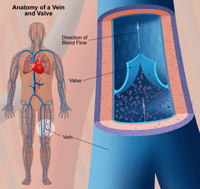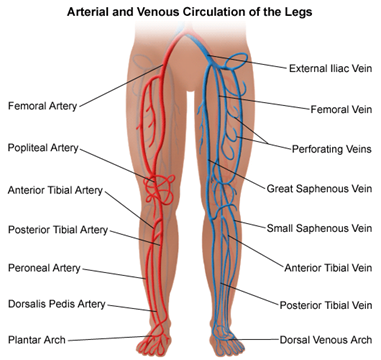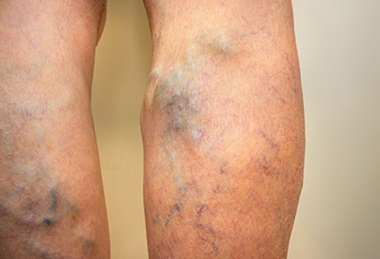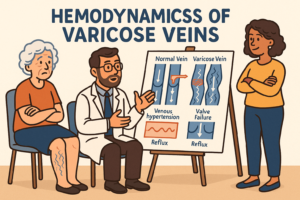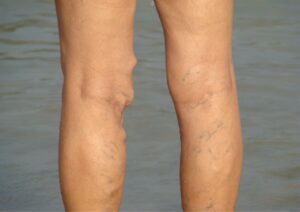Table of Contents
Blood clots and varicose veins are two common conditions that affect the circulatory system.
Blood clots occur when blood thickens and forms a solid mass, which can obstruct blood flow through a blood vessel. This can be dangerous if the clot travels to the lungs or brain, leading to a pulmonary embolism or stroke, respectively. Blood clots can also occur in veins close to the skin’s surface, causing a painful, red, and swollen area called superficial thrombophlebitis.
Varicose veins, on the other hand, are enlarged and twisted veins that usually occur in the legs. They happen when the valves inside the veins don’t function properly, leading to blood pooling in the veins and causing them to bulge. Varicose veins can cause discomfort, pain, and swelling, and may lead to skin changes, such as discoloration, thickening, or ulceration.
Both conditions can be influenced by a variety of factors, including genetics, age, obesity, pregnancy, prolonged standing or sitting, and certain medical conditions. Treatment options may include lifestyle changes, compression stockings, medications, or, in more severe cases, medical procedures or surgery. It’s important to consult a healthcare professional if you suspect you have blood clots or varicose veins to determine the appropriate course of treatment.
Blood Clots and Varicose Veins – Blood Clots
Varicoses vein is an abnormally enlarged vein under skin. Weak valves may raise blood pressure on legs, causing varicose veins. Our vein has a singleway valve that allows blood flow from the feet towards the heart. If this valve fails, blood accumulates in legs and pressure builds up. The vein becomes small, large and bent. Varicose veins usually occur at the knees and affect blood vessels near the surface of the skin. varicose veins also occur in other areas of the body.
What are varicose veins?
Varicose veins are enlarged, twisted veins. Varicose veins can happen anywhere in the body, but are more common in the legs.
Varicose veins may not be a severe medical matter, but they can still cause burdensome discomfort and lead to bigger health issues. On top of that, their unsightly appearance might make you feel embarrassed or uneasy in front of others.
What are spider veins?
Spider veins are an issue faced by many people; they have a sunburst or “spider web” pattern and can be seen through the skin. Often found on the face and lower legs, these milder varicose veins come in shades of red or blue – providing those with them quite a unique complexion!
What causes varicose veins?
Varicose veins are caused by increased blood pressure in the veins. Varicose veins happen in the veins near the surface of the skin (superficial).
The heart is constantly circulating blood throughout our body, and this process requires one-way valve systems within the veins. However, if these valves become weakened or damaged due to things like extended sitting and standing periods, then it can cause a backup of blood in the leg veins more quickly than normal – which creates pressure on their walls that lead them to stretch out! Ultimately damaging those same crucial valves we need for healthy circulation…what an ironic problem indeed!
What are the risk factors for varicose veins?
Varicose veins may be a family trait passed on through generations, caused by increased pressure in the veins. A variety of factors can increase this pressure – from lack of exercise to pregnancy and obesity.
Overweight or obesity
Older age
Being female
Being inactive
Leg injury
Pregnancy
Smoking
Taking oral contraceptive pills or hormone replacement
Deep vein thrombosis (DVT) is a dangerous medical condition caused by clots forming in the deep veins of our bodies. Though varicose veins can often be seen on the skin’s surface, they usually don’t cause any issues with blood clotting; however, severe cases may increase one’s risk for developing these serious problems. Blood clots demand immediate attention and are indicated through several physical symptoms such as extreme pain or tenderness while moving an area like your arm or leg, redness around that same spot, as well swelling at its source point. If you suspect anything related to this issue contact your doctor right away!
A life-threatening event may occur if a piece of blood clots breaks away and travel to the lungs. Known as pulmonary embolism, it can cause chest pain, breathing difficulties, coughing (involuntary ejection of blood), rapid heartbeat and sweating which could lead even worse symptoms like fainting. If you have these signs or an intuition that something is wrong–call 911! Don’t take any chances with your health; seek medical assistance immediately for best results.
What are the symptoms of varicose veins?
The following are the most common symptoms of varicose veins. However, each individual may experience symptoms differently. Symptoms may include:
Color changes in the skin
Sores on the legs
Rash
Sensations in the legs, such as a heavy feeling, burning, and/or aching
Varicose veins can lead to more serious skin issues such as troublesome ulcers and sores that will not heal. It is always best to consult a healthcare provider if you suspect varicose vein problems, in order for early diagnosis and treatment before any nasty side effects develop. How are varicose veins diagnosed?
A detailed medical history and physical exam are just the start when it comes to diagnosing varicose veins. To get a better understanding of blood flow and vein structure, doctors may use Duplex Ultrasound – an advanced type of vascular ultrasound that uses two types simultaneously!
What are the complications of varicose veins?
Varicose veins are usually not serious. But, complications may happen. They include:
Inflammation or swelling of veins (phlebitis)
Blood clots
What is a blood clot?
Blood clots are lumps of blood which begin to grow or become thinner. Clots comprise a mixture of platelet cells as well as fibrous tissue fiber cells. Clots function by preventing blood clots from bleeding from injuries and causing a rupture of vessels in a vein. The formation of blood clots during injury is beneficial as it reduces blood loss. Occasionally, blood clots can also cause death as a result. As blood vessels become clotted, these block oxygen circulating through the bloodstream, and may cause weakened tissues.
What causes blood clots in veins?
Causes: Deep vein thrombosis accompanied by sleeplessness, or standing long without movement. History of blood clot occurrences in the family. A catheter with a long-lasting inserted blood vessel. Obésity. ‘. :.
Why are varicose veins a sign of blood clots forming?
Varicose vein formation is indicative of possible bleeding because clots are developed in your legs due to valve malfunction. The blood pools and expands the vein which causes a varicose vein forming. In blood pools that have been accumulated through a lack of circulation, platelet clots form. The sight of varicosal vein on the outside shows the possibility of clot formation inside deeper.
Are blood clots more common with varicose veins?
Blood clot forms if blood vessels are damaged. The varicose vein is more susceptible to blood bleeding due to its lack of support to the vessels.
What happens if you get a blood clot in a varicose vein?
These superficial clots that may occur in varicose veins are able to increase swelling in the affected leg area.
Will a blood clot in a vein go away?
Although the normal clot of DVT dissolves in itself despite being present it is possible that pulmonary embolism may require treatment for DVT. Surgical treatment is necessary to restore normal circulation.
What happens if varicose veins are left untreated?
Leave varicoses untreated will cause deep vein thrombosis, a condition where clots develop in deeper veins. This disease has been very severe as a result and the blood clot may become loose in the lung and linger on it.
Do varicose veins in pregnancy cause blood clots?
In pregnancy, varicose veins cause blood clots that can increase. It is usually caused from veins underneath skin surfaces. The vein clots become hot, red and tender, indicating infection. SVT may spread through a deep vein and become life-threatening.
What are the dangers of varicose veins in pregnancy?
Varicose veins can occur in women pregnant during pregnancy. They’re a response to a new born child inside you. You can be certain that it is unlikely they’ll be gone when they give birth. Whenever someone experiences pain or other symptoms speak with a health practitioner.
When should I be worried about varicose veins in pregnancy?
Whenever you feel the vein is stiff, hot, or irritated, you should consult your physician. Varicose veins usually improve when pregnant with children when the ovary is not pushed into the superior vein of the cava.
What happens if you have a blood clot in your leg while pregnant?
When you develop DVT during pregnancy you may be required to have injections to stop clots forming to dissolve them. This medication dubbed heparine doesn’t impact baby development. This also reduces your risk of developing an enlarged vascular clot by injection.
What is the treatment for varicose veins?
Specific treatment for varicose veins will be determined by your healthcare provider based on:
Your age, overall health, and medical history
Extent of the condition
Your signs and symptoms
Your tolerance of specific medicines, procedures, or therapies
Expectations for the course of the condition
Your opinion or preference
Medical treatment may not be necessary if there are no symptoms. However, varicose veins may sometimes worsen without treatment.
Medical treatment may include:
Elevation of the legs:
If you have varicose veins, it’s important to keep your blood circulating! Elevating your feet several times a day for 15 minutes at a time can help reduce swelling and symptoms associated with them. For long periods of standing or sitting, flexing (bending) too often helps maintain circulation flow through the legs.
Compression stockings:
Compression stockings are an effective way to keep blood flowing – literally! Made with elastic material, these stocking squeeze your veins and ensure that even the smallest of capillaries get enough circulation. When worn every day they can make a real difference in helping people live better lives.
Sclerotherapy:
the remedy for those pesky spider and varicose veins! A saline or chemical solution is injected directly into damaged veins that are no longer capable of carrying blood, allowing other healthy ones to take over. Not only can this quick procedure make your skin look better, it also accelerates healing time so you’ll be back on your feet in a jiffy.
Thermal ablation:
Struggling with varicose veins? Lasers and radiofrequency energy can be used to target these pesky problems. With a precise catheter, your doctor will place an extremely small fiber in the vein which then uses intense heat from either of those two sources to break down its walls; effectively eradicating it This treatment is hassle-free and minimally invasive with fast recovery time.
Vein stripping:
Surgery to eliminate varicose veins is a medical procedure that can bring relief and restoring confidence in your legs!
Microphlebectomy:
Varicose veins may seem like more than a cosmetic problem, but they can be taken care of with minimally invasive techniques! Special tools are inserted through tiny incisions to remove these unsightly vessels. Some cases require the assistance of vein stripping for optimal results – so you don’t have to worry about them dragging your confidence down any longer!
Can varicose veins be prevented?
Steps to prevent varicose veins include:
Keeping a healthy weight
Exercising regularly
Putting your feet up while sitting
Not crossing your legs while sitting
Not wearing tight clothing
References
https://www.hopkinsmedicine.org/health/conditions-and-diseases/varicose-veins
https://www.healthdirect.gov.au/amp/article/varicose-veins
https://www.stoptheclot.org/blood-clots-and-varicose-veins/
https://www.mayoclinic.org/diseases-conditions/varicose-veins/symptoms-causes/syc-20350643



